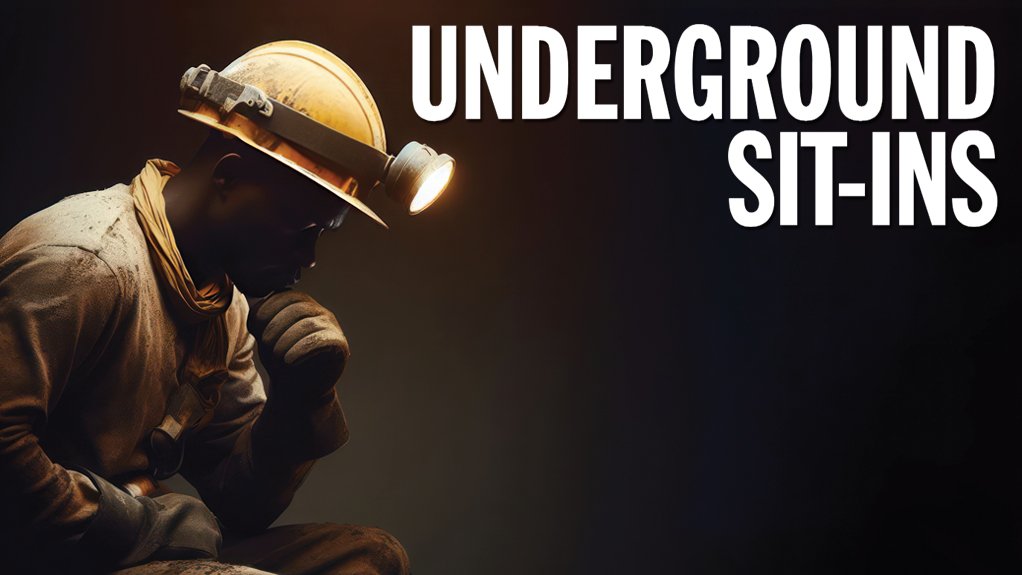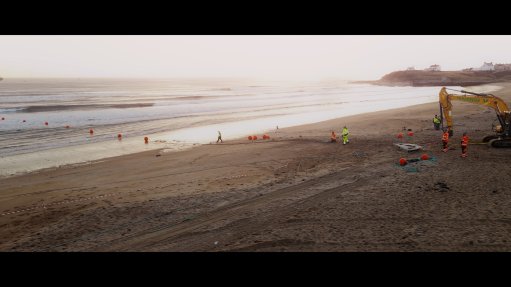Can SA mining prevent more hostage dramas in 2024?




UNION RIVALRIES As the South African mining industry contracts, the pond within which the unions can fish for members is also getting smaller
Photo by Creamer Media
ZIYAAD HASSAM There were fears that sending police or security teams underground would escalate the violence
Since October of last year, several unlawful underground protests have raised serious concerns about the potential emergence of a new trend in which frustrated underground mineworkers turn to unlawful sit-ins and hostage-taking as a means of having their demands met.
Although the South African mining industry is no stranger to legal and illegal protest action, this new direction is making trade union Solidarity Strategy Institute strategy and sustainability deputy secretary-generalPaul Mardonuneasy.
“Workers see these types of incidents happening and people ostensibly getting away with it, and they think this is a good idea. It's definitely becoming the norm, and this is something we must stand very firm against. This should never become the norm,” he tellsEngineering News & Mining Weekly.
Chain of Events
Starting on October 22 last year, about 543 mineworkers at gold mining company Gold One’s Modder East gold mine, in Gauteng, were held against their will for three days in an illegal underground protest action. The forced sit-in was initiated by Association of Mineworkers and Construction Union (AMCU) members who were frustrated that Gold One did not recognise AMCU as the majority union in light of the closed-shop agreement that it had previously held with the National Union of Mineworkers (NUM).
Following this incident, Gold One initiated investigations and disciplinary procedures against those involved, which resulted in 52 summary dismissals. During this period, a company investigator who was looking into the October incident was murdered.
Following these dismissals, angry workers at Modder East staged a second illegal sit-in in December, once again taking about 400 fellow mineworkers hostage underground to protest the dismissal of those involved in the first incident.
Also in December, unionised workers staged an illegal three-day underground sit-in at platinum miner Wesizwe Platinum’s Bakubung platinum mine outside Rustenburg, in the North West province.
The mineworkers were demanding higher wages despite the company announcing a week earlier that it would need to retrench about 75% of its workforce, owing to poor platinum prices and multiple work stoppages caused by protest action, causing the mine to become unprofitable.
The same month, more than 2 000 workers staged an illegal underground sit-in at the North and South shafts at platinum major Impala Platinum’s Bafokeng Rasimone platinum mine, in the North West. During this incident, the NUM claimed that its members were once again being held hostage as part of an illegal protest action over pension funds and the employee share scheme.
An Emerging Trend
With several of these events happening in quick succession, there is growing concern that illegal underground sit-ins accompanied by hostage taking is rapidly becoming a new trend.
“We were the trendsetter in an unfortunate way because of the other sit-ins that happened after the October incident. It perhaps gave unions an idea of a different approach to protest action,” Gold One Modder East legal headZiyaad HassamtellsEngineering News & Mining Weekly.
If holding people against their will was not enough, the situation at Gold One turned violent, with several acts of assault by employees against other employees.
Hassam says the unfortunate reality is that there is not a lot that can be done once the workers travel underground. Once miners are at the surface, perpetrators can be dealt with and negotiations can be carried out to facilitate labour stability. Additional security can also be added to conduct more thorough searches before the mineworkers go underground.
“However, once people go underground in large numbers, there are numerous mining tools and instruments there that can easily be used as weapons. Sending security underground poses a threat to the security members themselves and it is very difficult for security to cover such large underground areas effectively.”
He adds that this also makes it difficult to prevent such flare-ups from happening again.
“If enough people get together and choose to sit in underground, it's actually very difficult to stop. The police were reluctant to go underground, simply because they felt that if they were to go underground, it would just be seen as a provocation and would potentially lead to injuries and maybe even loss of life.”
He cites the infamous Marikana incident in 2012, where 34 mineworkers were gunned down by police after protest action turned violent, sparking public outrage locally and internationally.
Hassam believes the only way to effectively prevent further underground hostage situations is to demonstrate zero tolerance towards perpetrators to dissuade any future attempts by others to do the same.
“As with any company, we cannot back down when faced with illegal criminal activity. We would completely lose authority at the mine if we were to allow these sorts of actions to go unpunished.”
In this light, about 500 Gold One mineworkers have been dismissed, as a direct result of their involvement in the hostage dramas last year at Modder East.
However, Hassam is concerned that such widescale dismissals, although warranted, could lead to further violent protests.
While the company has taken in-house disciplinary steps, Hassam is not aware of any criminal charges being brought against those involved.
“The nature of criminal charges is that the individuals concerned would need to follow through with them. So, we've encouraged all employees who were underground and particularly those who are victims of assault to lay individual criminal charges.”
It is highly likely that many of the victims would not bring criminal charges against the perpetrators for fear of retaliation: “I think manyemployees are still operating in a climate of fear, and that will remain until the chief instigators have been dealt with and removed from the company,” Hassam admits.
Mardon believes it is essential that criminal cases be opened.
“That is something that we don't see much about happening at this stage. Some very serious offences were committed during the December sit-in at Modder East. Serious assaults and even attempted murder. Kidnapping in itself is a serious offence. The intimidation that took place, as well as the racism,” he notes.
Hassam adds that improved intelligence could be effective at pre-empting such illegal protest action, but believes that stable labour relations are key.
However, there is a limit to how much control a company can have over this, as “it becomes difficult to ensure stable labour relations when the conflict is between rival unions”, says Mardon.
What Now?
Regarding the instability caused by the rivalry between AMCU and the NUM at Gold One’s operations, Hassam believes it is likely that the company has not seen the end of the trouble just yet.
Currently, AMCU’s application for recognition as a trade union at the mine has been submitted to Gold One, with the verification process being facilitated by the Council for Conciliation, Mediation and Arbitration.
“We understand that the situation at the mine is still unstable and volatile, and that if any party is unhappy with the outcome of the process, there could potentially be further unrest and instability.
“As a company, we've no vested interest in either union holding a majority. We are fully prepared to go along with the fair legal process and we will respect the outcome, whatever that may be. We've asked both unions and employees to do the same,” Hassam explains.
Mardon believes that the effect of such a trend on the South African mining industry, if left unchecked, would result in a downward spiral, with the potential for much bigger and more intense conflict to erupt in future.
“The problem is that our mining industry is getting smaller and smaller, which means that the pond within which the unions can fish for members is also getting smaller and smaller, so the competition is getting worse.”
Consequently, the increased economic pressure would, ultimately, lead to more retrenchments, he adds.
“We are going to see more retrenchments this year. That's a fact, whether we want to or not. This all leads to a loss or decrease in investment confidence in South Africa and in those particular mines.”
Most concerning to Mardon, however, was how these events took the focus away from health and safety, undermining all the progress that the mining industry has made over the past few decades.
“It elevated labour relations issues to be higher and more important than health and safety. Now, that can never be. This is totally wrong. This holds a huge risk for the total collapse of health and safety in mining, which will lead to a total collapse in labour relations as well,” he concludes.
Article Enquiry
Email Article
Save Article
Feedback
To advertise email advertising@creamermedia.co.za or click here
Comments
Press Office
Announcements
What's On
Subscribe to improve your user experience...
Option 1 (equivalent of R125 a month):
Receive a weekly copy of Creamer Media's Engineering News & Mining Weekly magazine
(print copy for those in South Africa and e-magazine for those outside of South Africa)
Receive daily email newsletters
Access to full search results
Access archive of magazine back copies
Access to Projects in Progress
Access to ONE Research Report of your choice in PDF format
Option 2 (equivalent of R375 a month):
All benefits from Option 1
PLUS
Access to Creamer Media's Research Channel Africa for ALL Research Reports, in PDF format, on various industrial and mining sectors
including Electricity; Water; Energy Transition; Hydrogen; Roads, Rail and Ports; Coal; Gold; Platinum; Battery Metals; etc.
Already a subscriber?
Forgotten your password?
Receive weekly copy of Creamer Media's Engineering News & Mining Weekly magazine (print copy for those in South Africa and e-magazine for those outside of South Africa)
➕
Recieve daily email newsletters
➕
Access to full search results
➕
Access archive of magazine back copies
➕
Access to Projects in Progress
➕
Access to ONE Research Report of your choice in PDF format
RESEARCH CHANNEL AFRICA
R4500 (equivalent of R375 a month)
SUBSCRIBEAll benefits from Option 1
➕
Access to Creamer Media's Research Channel Africa for ALL Research Reports on various industrial and mining sectors, in PDF format, including on:
Electricity
➕
Water
➕
Energy Transition
➕
Hydrogen
➕
Roads, Rail and Ports
➕
Coal
➕
Gold
➕
Platinum
➕
Battery Metals
➕
etc.
Receive all benefits from Option 1 or Option 2 delivered to numerous people at your company
➕
Multiple User names and Passwords for simultaneous log-ins
➕
Intranet integration access to all in your organisation



















